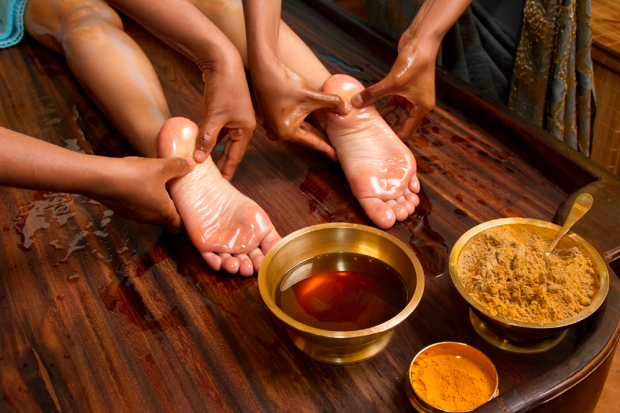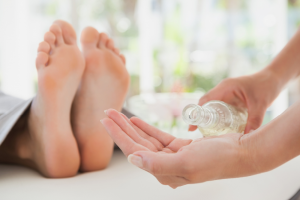Ancient Therapy The Miraculous Power of an Ayurveda Foot Massage
Stemming from ancient Indian medicine, an Ayurveda foot massage (Padabhyanga) has the ability to heal, revitalize and improve circulation in the entire body. Find out all you need to know about this special type of massage and how it can benefit your overall health.
An ancient Indian saying suggests that disease never goes near a person who massages his or her feet before sleeping, just as snakes do not approach eagles. While this specific message has never been proven, daily foot rubs do have the ability to relax the body, increase circulation, reduce stress and offer healing benefits for illnesses. Ayurvedic Padabhyanga — an Indian massage known as an ayurveda foot massage — is especially helpful in these areas.
What Is An Ayurveda Foot Massage?
Translated as “life knowledge,” Ayurveda is a form of alternative/complimentary medicine with roots tracing back to the Indian subcontinent. The practice suggests that there are three elemental substances in the body (doshas called Vata, Pitta and Kapha) that result in health if they are balanced, illness if they are unbalanced. Furthermore, suppressing natural urges is considered unhealthy and said to be the cause of many illnesses and health problems, as is a blockage of fluids in certain channels called srotas. Ayurveda foot massages use aromatic oils and Swedana (fomentation) to unblock these channels and restore the transport of bodily fluids. As a result, the entire body and nervous system are affected.
Benefits of An Ayurveda Foot Massage
Daily ayurvedic foot rubs have many health benefits, including the ability to:
- Promote better sleep
- Relax the body’s physiology
- Increase energy
- Provide revitalization
- Maintain eyesight and hearing
- Alleviate certain foot pains
- Calm the mind and reduce stress
- Nourish foot skin
- Improve foot and leg muscle tone
- Prevent sciatica
- Boost immunity
- Aid digestion
- Balance emotions
- Ward off bacterial and fungal infections
- Keep the body’s dosha in balance
- Provide sturdiness to the limbs
- Cure headaches
- Relieve menstraul symptoms
The massage can be used to calm a variety of ailments, including anxiety, depression, diabetes, insomnia, heel fissures and cracked skin, hypertension, and cramps, sprains and numbness in the feet.
Typical Ayurvedic Massage Practices
There are many aromatic oils used during the practice of Ayurveda, but sesame oil is the one most commonly used. The oil is extremely nourishing for the skin and acts a powerful antioxidant. Medicated ghee can also be used, depending on a person’s health situation.
Some Ayurvedic masseuses use a small bronze bowl called a Kasa during the massage. The bowl is warmed and oiled before being rubbed on the feet. This technique is said to increase energy flow to the area and stimulate circulation.
How To Give Yourself An Ayurveda Foot Massage
To perfect the practice of ayurvedic massage, start by soaking your feet in a warm bath filled with your choice of salts and herbs. Crushed ginger and sea salt are commonly recommended. When you feel ready, dry your feet and apply a very generous amount of sesame oil or coconut oil to one foot and apply the following ayurveda massage techniques with a duration of about 10 to 15 minutes per foot:
- Massage the ankle and lower calf area, using your fingers and thumbs to apply firm but comfortable pressure in downward strokes.
- Massage the area just below your ankle, using circular strokes under the ankle bone.
- Move to your toes and gently massage each toe, beginning with the small toe and working your way toward the largest toe. Be sure to apply massaging motion to the area between the toes with your thumb and forefinger.
- When you get to your big toe, used you fingers to pull it away from the others and gently stretch and loosen the muscles. Then go back and it do for the other four toes.
- Use your thumbs to apply firm pressure to the toe pads and ball of the foot and then use long strokes all along the sole of the foot. You can do this by bending your leg and placing your ankle on the opposite leg so your foot is facing upward.
- Continue using your thumbs and apply firm pressure and circular motion to the arch of the foot and the heel.
- Intertwine your fingers with your toes and gently rotate your foot in a clockwise and then counterclockwise direction to loosen up the ankle and leg muscles.
- Finish by rubbing the sole of the foot once more before using your palm to slap the area, which is thought to increase circulation.
- Repeat the same steps on the opposite foot.
- If desired, you can finish with an additional salt footsoak to further draw out stress and toxins from the feet.
Notice concerning medical entries:
Articles having medical content shall serve exclusively for the purpose of general information. Such articles are not suitable for any (self-) diagnosis and treatment of individual illnesses and medical indications. In particular, they cannot substitute for the examination, advice, or treatment by a licensed physician or pharmacist. No replies to any individual questions shall be effected through the articles.





